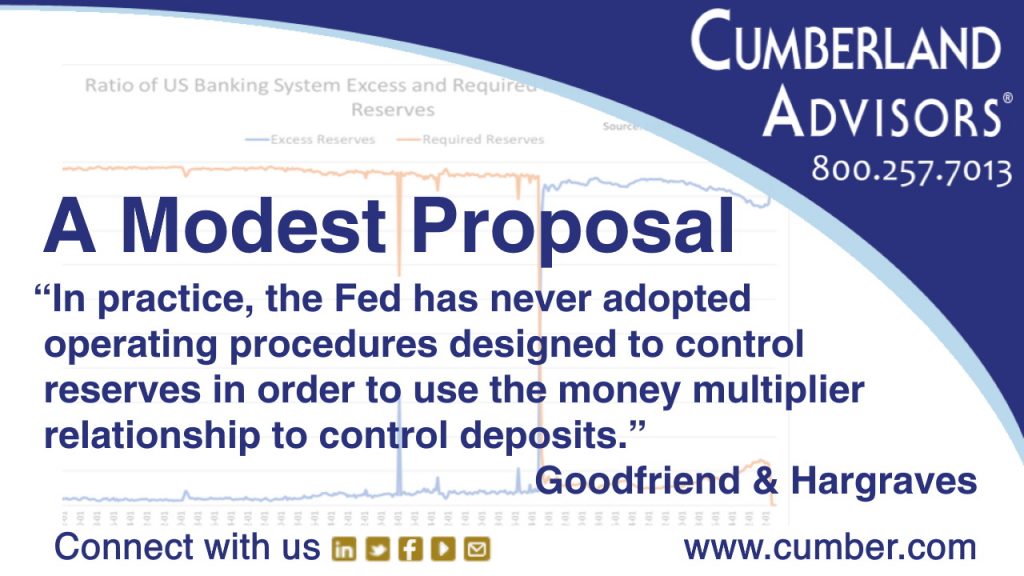
- Raise reserve requirements to sterilize as much of the existing excess reserves as possible, e.g. perhaps up to 80%. This move will be especially important since most of the COVID-19 rescue package seems to have ended up on the Fed’s balance sheet.
- Commit to cut required reserves in parallel with the decline in the Fed’s balance sheet as assets mature and run off.
- Adjust the actual ratio applied to ensure that excess reserves are sufficient to provide adequate liquidity in the overnight federal funds market as well as the tri-party repo market.
- Vary the size of the excess reserve buffer created by a required reserve ratio less than 100% as an additional policy tool when markets change as the economy recovers. The flow of liquidity and pricing in the tri-party repo market could serve as the canary in the mine to indicate how large the buffer should be to ensure smoothly functioning financial markets. We saw, for example, in the fall of 2019, that there was a miscalibration on the part of the Fed as to how big its balance sheet should be, which resulted in a spike in the repo rate that went away only when the Fed introduced an emergency repo facility to support that market.
- Establish a different reserve requirement rate for large banks and for branches and agencies of foreign institutions, because reserve balances are not evenly distributed across banks of all sizes. Note that before the Fed reduced reserve requirements to zero, required reserves were zero for banks with eligible deposits up to $16 million, 3% for banks with eligible deposits up to $122.3 million, and 10% thereafter. So, there is historical precedent for differential reserve requirements. Right now, the 25 largest banks hold 61% of the deposits and have 56% of the reserves. Agencies and branches of foreign institutions hold only 7% of US deposits but hold 24% of the reserves. US chartered banks not in the top 25 together hold 32% of the deposits and only 20% of the reserves. Since the objective is to sterilize the excess reserves, it also makes sense, as was the case in the past, to establish different requirements for different-sized institutions, especially since 85% of the reserves are in just a few institutions and their propensity to lend and expand credit varies. At the same time, a lower reserve ratio that might continue to be zero for small institutions would ensure that these banks can accommodate individual and small business loan demand in their local communities. Because the objectives are to prevent an explosion in the money supply and a runup in inflation, to manage a smooth transition to a smaller Fed balance sheet, and to avoid having to sell assets, there is no economic justification for the Fed’s having reduced reserve requirements to zero last March.
- Establish different interest rates that the Fed pays on excess reserves as opposed to the rate paid on required reserves. This strategy would enable the Fed to dynamically control the opportunity costs of holding excess reserves as opposed to the incentives for expanding credit and shifting excess reserves into required reserves. With a rate on required reserves greater than the rate on excess reserves, for example, institutions would be incentivized on the margin to make loans rather than to hold reserves idle in the form of excess reserves. A zero rate on excess reserves would provide an additional stimulus and would not require maintaining a lower federal funds rate, which might otherwise be required. On the other hand, setting the rate on excess reserves greater than that on required reserves would tend to dampen incentives to expand lending on the margin. Thus, employing differential rates on required and excess reserves provides an additional tool for fine-tuning reserve holding incentives as a complement to differential reserve requirements themselves, which are not well suited for day-to-day adjustments in monetary policy.
Links to other websites or electronic media controlled or offered by Third-Parties (non-affiliates of Cumberland Advisors) are provided only as a reference and courtesy to our users. Cumberland Advisors has no control over such websites, does not recommend or endorse any opinions, ideas, products, information, or content of such sites, and makes no warranties as to the accuracy, completeness, reliability or suitability of their content. Cumberland Advisors hereby disclaims liability for any information, materials, products or services posted or offered at any of the Third-Party websites. The Third-Party may have a privacy and/or security policy different from that of Cumberland Advisors. Therefore, please refer to the specific privacy and security policies of the Third-Party when accessing their websites.
Sign up for our FREE Cumberland Market Commentaries
Cumberland Advisors Market Commentaries offer insights and analysis on upcoming, important economic issues that potentially impact global financial markets. Our team shares their thinking on global economic developments, market news and other factors that often influence investment opportunities and strategies.


